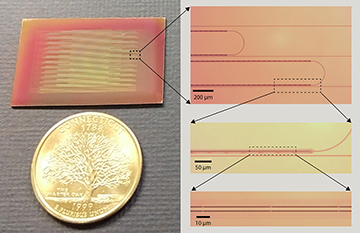The Rakich-led team’s Brillouin integrated silicon laser system (left) includes racetrack resonators, with long straightaways that that confine both light and sound waves to produce laser gain from the nonlinear effect of stimulated Brillouin scattering (right). [Image: Yale University, Otterstrom et al.] [Enlarge image]
One stumbling block in the development of silicon photonics has been the difficulty of achieving integrated silicon lasers. A team led by scientists at Yale University, USA, has now leveraged a recently developed hybrid photonic-phononic (light-sound) waveguide to create a silicon-based device that achieves lasing by harnessing the nonlinear Brillouin effect (Science, doi: 10.1126/science.aar6113). The researchers believe that the system provides “a platform to develop a range of applications for monolithic integration within silicon photonic circuits.”
Band-gap mismatch
The difficulty of developing all-silicon lasers stems from the material’s indirect band gap, which makes radiative recombination and photon emission far less likely than in direct-band-gap materials. As a result, integrated photonic systems in silicon commonly either use external lasers tied to the silicon chip with fiber optics, or rely on techniques to bond lasers made of direct-band-gap, group III–V semiconductors, such as indium phosphide, to a silicon wafer substrate.
While those techniques have made dramatic strides in recent years (see “III-V-on-silicon integration,” OPN, March 2017), a native silicon laser that can seamlessly, monlolithically integrate directly on a chip with other silicon devices, and thereby take advantage of established CMOS fabrication processes, has remained something of a holy grail. One approach in developing those lasers could lie in tapping nonlinear effects, such as the Raman effect or stimulated Brillouin scattering (SBS), to provide light amplification and lasing.
A nonlinear path to lasing
SBS in particular occurs when light traveling through a medium interacts with a material to create vibrations, or phonons—basically quanta of sound—within the medium. When a pump photon traveling through a medium interacts with such a phonon, the pump light scatters into a lower-energy, lower-frequency “Stokes” photon and another phonon, which reinforces the effect.
SBS has long been a bane in fiber optic communications, where the counterpropagating Stokes wave in the fiber can degrade signal quality. In the context of an optical resonator, however, SBS can lead to lasing at the Stokes frequency if the optical gain from SBS overcomes the round-trip loss of pump energy. Brillouin lasers have been designed on just such principles in a variety of materials, such as chalcogenide glasses. But Brillouin lasing has been difficult to achieve in conventional silicon waveguides, as acoustic dissipation in the silicon substrate limits light-sound coupling to below the sweet spot needed for laser gain.
Trapping light and sound
The Yale team, led by OSA member Peter Rakich, wanted to see if the dissipation problem could be overcome by a new “suspended” silicon waveguide that the lab had been developing over the past several years. The waveguide—a tiny silicon channel that hovers over the substrate and is held in place by a series of nanoscale tethers—tightly confines both acoustic and light energy, allowing for strong Brillouin interactions.
To turn those interactions into a laser, the team fashioned, using a single-crystal silicon-on-insulator wafer, a 4.6-cm-long “racetrack” resonator cavity. The two long straightaways of the racetrack consist of the suspended waveguides, which confine both light and sound energy and allow the SBS interaction to occur; the bends at either end of the racetrack are non-suspended, more conventional waveguides that guide only light (see image above). Pump light at telecom frequencies, coupled into the resonator, gives rise to SBS in the straightaways, with the Stokes light amplified as it repeatedly circulates through the resonator. Eventually, the Stokes light reaches the lasing threshold and is emitted as laser light.
Coherent light and sound
The team used a heterodyne-spectroscopy setup to confirm the action of the Brillouin laser, and in particular to characterize the light’s coherence and to demonstrate a thousand-fold narrowing of the Stokes linewidth in the laser regime. More surprisingly, the researchers also noted a narrowing of the linewidth of the phonon, or vibrational, field as well—creating what the paper’s first author, OSA student member Nils Otterstrom, referred to in a press release as “very coherent hypersonic waves” in addition to the optical laser.
The team believes that the design provides a potential route to monolithically integrated silicon lasers, and offers a platform for creating “a multitude of laser designs, each with unique dynamics and potential applications,” according to Ryan Behunin, a study coauthor and former member of Rakich’s lab who’s now affiliated with Northern Arizona University. The new device and its capabilities, he argues, “dramatically expand our ability to control and shape light in silicon photonic circuits.”

